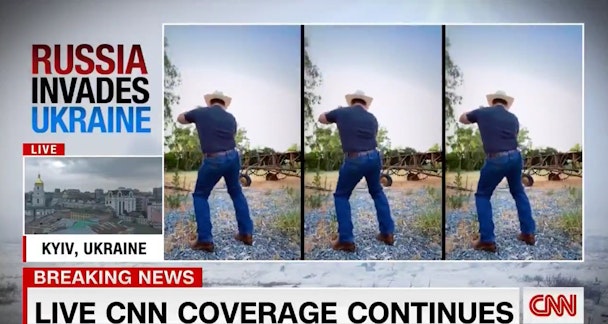Media agencies struggling to keep brands advertising around bleak Ukraine news cycle
When Applebee’s dancing cowboy ad interrupted CNN’s Ukraine war report last week, it quickly became the subject of social media mockery, leading it to pull ads and CNN to overhaul its ad placements against news. But Applebee’s isn’t the only brand concerned about advertising next to war coverage. The Drum caught up with media agencies about what they’re seeing.

Media agencies struggling to keep brands advertising around bleak Ukraine news cycle
According to reports, publishers have seen a significant drop in ad revenue as brands pull spend over concerns of appearing against news of the Russian invasion. It is, arguably, an unsurprising trend. This happened with Covid-19 coverage, while for minority media it is a daily reality according to this report from the News Media Alliance. And, once again, it has sparked criticism from the media that advertisers are failing to fund the free press.
Marketers hate interrupting, pausing or altering their media plans. It requires a lot of extra effort and expense, with the ultimate result of reaching fewer consumers. During conflicts, however, they worry about being caught directly funding or being associated with disinformation or propaganda, either on user-generated content where it is difficult to control placements or on dodgy web domains. The speed at which Russian state broadcaster RT is being de-platformed is reflective of that fear.
A brand safety consultant steering some of the world’s highest-spending advertisers told The Drum that clients are “very” worried about appearing next to distressing information, which includes but is not limited to news as well as misinformation. On social platforms specifically, they are gauging the volume of risky content and how well it is being moderated. The tech platforms have launched a raft of protective measures this week in response.
Jake Dubbins, co-chair of the Conscious Advertising Network, says: “If your ads are running on Russian state TV at the moment, then Jesus, you’ll soon be seeing the screenshots.“
There’s a real risk of clashes in news, he says. “If you’re running an ad about celebrating joy besides harrowing footage, then you can be accused of being tone-deaf. But pulling wholesale out of news would not be a great idea either.”
While Applebee’s was caught off guard this week, UK price comparison firm Compare the Market took a proactive approach. Its animated meerkat oligarch mascots have been on screens since 2009, but the company pulled ads from TV news for fear of appearing insensitive.
Clare Atkin, co-founder of Check My Ads, warns brands to consider the alternative, however – if they’re not in news, are they absolutely sure where they’ll be advertising instead? For years, Atkin and co-founder Nandini Jammi have been unraveling how marketing dollars have been streaming into misinformation networks, and they’ve drawn multiple connections with Russian influence.
“It is a long-time tactic of Russia to cause chaos within a media sphere in their enemies. Russian disinformation networks are asynchronous and decentralized, with little independent platoons that are incredibly effective. They have permeated western nations’ politics with outright conspiracy theories, racism, xenophobia and hate.”
She blames the adtech supply chain that isn’t quite stocking shelves with the premium inventory it purports to. She advises: “Check your ads, learn what is out there, learn what you’re funding. If you’re not at least thinking about making an inclusion list, then you’re behind. Your ad money is being spent willy-nilly, causing an incredible amount of waste and sowing absolute chaos in the real world.”
For those panicking about appearing next to misinformation and propaganda – or even news – our brand safety source says “a smart agency would have blocked the bad stuff years ago…” For those that didn’t, however, there is some advice for acting now:
-
Instead of relying on brute force blocklists, use pre-bid segments where possible – words like ’Ukraine’, ’War’ and ’Putin’ are common additions to blocklists this week
-
Report misinformation to platforms when you see it
-
Work with vetted media and place ads on vetted domains and apps
-
Use social media tools to limit negative adjacencies
-
Be mindful of in-feed environments where people can express very strong opinions.
-
Don’t be tone-deaf – try to understand the local sentiment
-
Fund quality journalism
-
Use keywords only if you have to, do not block positive content
-
Block known misinformation/propaganda channels
-
Employ empathy and common sense
In addition to this, the Conscious Advertising Network’s Dubbins advises: “Know where your ads are, consciously choose your partners. Don’t be lazy and go total brand safety on the safest stuff. Make the fucking effort to align the values of your brand with the media environments that you’re in – that might be small quality environments too.”
The top ad networks have shared how they are addressing the Ukraine crisis but have stopped shy of revealing client specifics.
Dentsu did offer this line to The Drum (which was more than other groups we approached): ”We cannot speculate on the long-term economic impact of the ongoing escalation between Russia and Ukraine. We are confident that our teams across Europe will support our clients’ ongoing activities in the regions and provide appropriate consultation to minimize any potential impact due to ongoing sanctions on Russia.”
Another source at a top media network told us: ”The world is in shock at what’s happening. We’ve got clients in lots of markets and the advice differs depending on how impacted that market is.”
They went on to say they are advising their clients to continue advertising (especially in news) after ”quickly reflecting on what is going out and making sure it’s appropriate as it may have been pre-scheduled content”. They added: ”We don’t want anything to be misconstrued, so it’s about iterating and reassessing plans for sentiments, language and visual cues, or anything that might be deemed insensitive and inappropriate.”
Brands might also see the benefit of reminding consumers that the world continues to spin, with our source telling us: ”There is very much a sense of ’let’s see how we can project some kind of stability and communicate that everything is still functioning’ in most markets.”
News media represents some of the most engaging content on the internet. People need it and studies suggest the risk of negative juxtapositions is over-stated, outweighed by the benefits brought by the medium.

